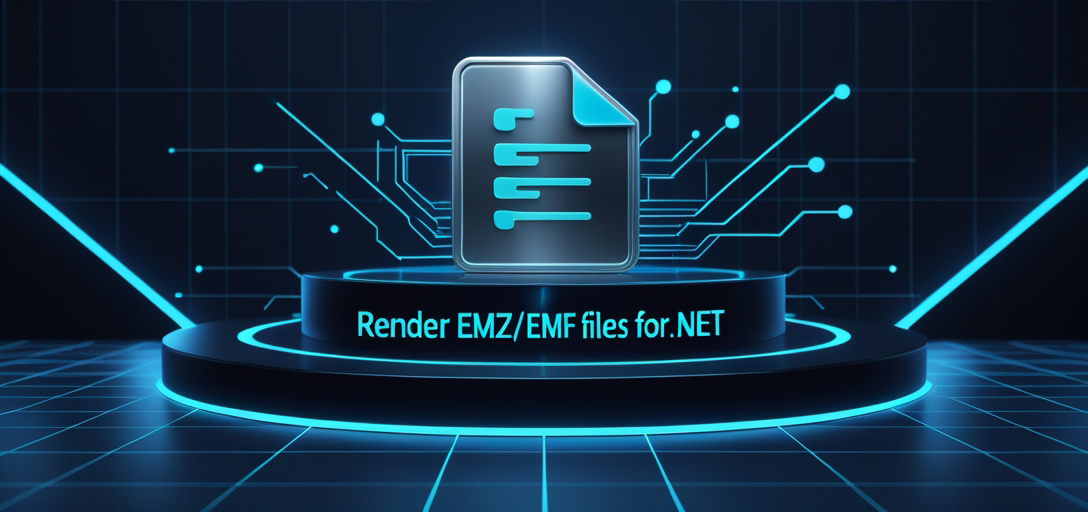How to Render EMZ/EMF Files Using GroupDocs.Viewer .NET: A Comprehensive Guide
Rendering Basics
This tutorial demonstrates how to render Enhanced Metafile (EMF) or Embedded Metafile (EMZ) files using GroupDocs.Viewer for .NET. Whether you’re integrating versatile file conversion capabilities into your application or managing documents, this guide covers rendering these formats into HTML, JPG, PNG, and PDF.

Prerequisites
- Libraries: Ensure you have GroupDocs.Viewer for .NET (version 25.3.0).
- Environment: Use a .NET development environment like Visual Studio.
- Knowledge: Familiarity with C# programming and basic file handling in .NET is required.
Setting Up GroupDocs.Viewer for .NET
To use GroupDocs.Viewer, install it via the following methods:
NuGet Package Manager Console
Install-Package GroupDocs.Viewer -Version 25.3.0
.NET CLI
dotnet add package GroupDocs.Viewer --version 25.3.0
License Acquisition
You can obtain a free trial, temporary licenses for extended evaluation, or purchase full functionality from the GroupDocs Purchase Page.
Basic Initialization and Setup
Initialize GroupDocs.Viewer in your .NET application as shown:
using GroupDocs.Viewer;
// Initialize Viewer object with an EMZ file path.
using (Viewer viewer = new Viewer("YOUR_DOCUMENT_DIRECTORY/TestFiles.SAMPLE_EMZ"))
{
// Configuration options go here.
}
Implementation Guide
Explore how to render EMZ/EMF files into various formats:
Rendering EMZ/EMF to HTML
Overview
Convert an EMZ file into HTML with embedded resources for web applications.
Step 1: Set Up Output Directory
string outputDirectory = Path.Combine("YOUR_DOCUMENT_DIRECTORY", "output");
string pageFilePathFormat = Path.Combine(outputDirectory, "emz_result.html");
Step 2: Configure HTML View Options
Embed resources directly in the HTML using HtmlViewOptions.
using (Viewer viewer = new Viewer(Path.Combine("YOUR_DOCUMENT_DIRECTORY", "TestFiles.SAMPLE_EMZ")))
{
HtmlViewOptions options = HtmlViewOptions.ForEmbeddedResources(pageFilePathFormat);
viewer.View(options);
}
Explanation: ForEmbeddedResources ensures all resources are embedded, making the HTML self-contained.
Rendering EMZ/EMF to JPG
Overview
Convert EMZ files into JPEG images for easy sharing or display in applications where image formats are preferable.
Step 1: Set Up Output Directory
string outputDirectory = Path.Combine("YOUR_DOCUMENT_DIRECTORY", "output");
string pageFilePathFormat = Path.Combine(outputDirectory, "emz_result.jpg");
Step 2: Configure JPEG View Options
Use JpgViewOptions to render the file as a JPEG.
using (Viewer viewer = new Viewer(Path.Combine("YOUR_DOCUMENT_DIRECTORY", "TestFiles.SAMPLE_EMZ")))
{
JpgViewOptions options = new JpgViewOptions(pageFilePathFormat);
viewer.View(options);
}
Explanation: JpgViewOptions simplifies the conversion process directly to a JPEG file.
Rendering EMZ/EMF to PNG
Overview
Generate high-quality PNG images from your EMZ files, which support transparency and are useful for web graphics.
Step 1: Set Up Output Directory
string outputDirectory = Path.Combine("YOUR_DOCUMENT_DIRECTORY", "output");
string pageFilePathFormat = Path.Combine(outputDirectory, "emz_result.png");
Step 2: Configure PNG View Options
Render using PngViewOptions.
using (Viewer viewer = new Viewer(Path.Combine("YOUR_DOCUMENT_DIRECTORY", "TestFiles.SAMPLE_EMZ")))
{
PngViewOptions options = new PngViewOptions(pageFilePathFormat);
viewer.View(options);
}
Explanation: PNGs provide lossless compression, maintaining image quality.
Rendering EMZ/EMF to PDF
Overview
Convert your EMZ files into PDF documents for universal accessibility and sharing across platforms.
Step 1: Set Up Output Directory
string outputDirectory = Path.Combine("YOUR_DOCUMENT_DIRECTORY", "output");
string pageFilePathFormat = Path.Combine(outputDirectory, "emz_result.pdf");
Step 2: Configure PDF View Options
Utilize PdfViewOptions for creating a PDF.
using (Viewer viewer = new Viewer(Path.Combine("YOUR_DOCUMENT_DIRECTORY", "TestFiles.SAMPLE_EMZ")))
{
PdfViewOptions options = new PdfViewOptions(pageFilePathFormat);
viewer.View(options);
}
Explanation: Converting to PDF ensures compatibility and ease of distribution.
Practical Applications
Integrate GroupDocs.Viewer into systems for various purposes:
- Document Management Systems: Convert uploaded EMZ/EMF files for web viewing.
- Archiving Solutions: Store legacy formats as accessible PDFs or images.
- Web Portals: Display graphics using HTML or image files.
Performance Considerations
Optimize performance when using GroupDocs.Viewer:
- Use asynchronous methods to avoid UI blocking.
- Monitor memory usage and dispose of objects promptly.
- Batch process documents during off-peak hours for better server utilization.
Conclusion
This guide has shown how to render EMZ/EMF files into various formats using GroupDocs.Viewer for .NET, enhancing your development toolkit. Consider exploring advanced configuration options or integrating these conversions into larger projects next.
FAQ Section
- Handling Large Files: Use asynchronous processing and ensure adequate system resources.
- Other File Types: GroupDocs.Viewer supports Word, Excel, PDFs, and more.
- Output Resolutions: Specify resolution settings when configuring image view options.
- Non-existent Output Directory: Ensure your code checks and creates necessary directories before rendering.
- Customizing PDF Appearance: Customize margins, orientation, and other settings in PDF outputs.